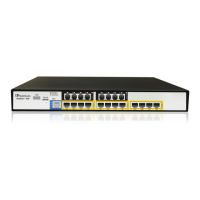[ForwardOnBusyTrunkDest]
FORMAT ForwardOnBusyTrunkDest_Index =
ForwardOnBusyTrunkDest_TrunkGroupId,
ForwardOnBusyTrunkDest_ForwardDestination;
[\ForwardOnBusyTrunkDest]
For example, the below configuration forwards IP-to-Tel calls to
destination user “112” at host IP address 10.13.4.12, port 5060,
using transport protocol TCP, if Trunk Group ID 2 is unavailable:
ForwardOnBusyTrunkDest 1 = 2,
112@10.13.4.12:5060;transport=tcp;
Note: For a detailed description of this table, see 'Alternative Routing
to IP Destination upon Busy Trunk' on page 346.
66.11.15 Number Manipulation Parameters
The number manipulation parameters are described in the table below.
Number Manipulation Parameters
Parameter Description
[ManipulateIP2PSTNRefer
To]
Enables the manipulation of the called party (destination) number
according to the SIP Refer-To header received by the device for TDM
(PSTN) blind transfer. The number in the SIP Refer-To header is
manipulated for all types of blind transfers to the PSTN (TBCT, ECT,
RLT, QSIG, FXO, and CAS).
[0] Disable (default)
[1] Enable
the destination number of this call can be manipulated if this parameter
is enabled. When enabled, the manipulation is done as follows:
1 If you configure a value for the xferPrefix parameter, then this value
(string) is added as a prefix to the number in the Refer-To header.
2 This called party number is then manipulated using the IP-to-Tel
Destination Phone Number Manipulation table. The source number
of the transferred call is taken from the original call, according to its
initial direction:
Destination number of the original call if it is an IP-to-Tel call
This source number can also be used as the value for the 'Source
Prefix' field in the IP-to-Tel Destination Phone Number Manipulation
table. The local IP address is used as the value for the 'Source IP
Address' field.
Note: This manipulation does not affect IP-to-Trunk Group routing rules.

